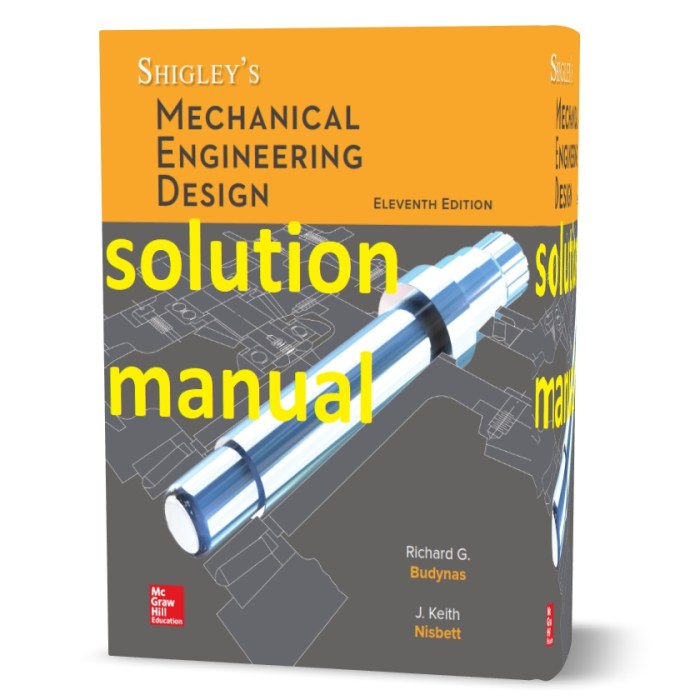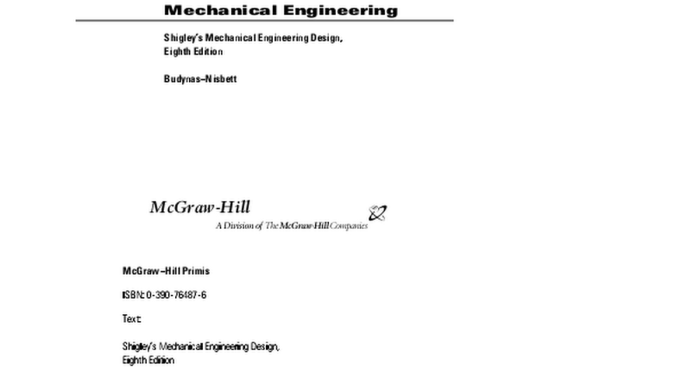Shigley’s Mechanical Engineering Design Shigley Solutions PDF offers a comprehensive resource for students and practitioners in the field of mechanical engineering. Its accessibility and portability in PDF format make it an invaluable tool for anyone seeking to enhance their understanding of design principles, materials, and machine elements.
This guide provides a detailed overview of the book’s structure, key sections, and design principles. It explores the application of these principles to real-world engineering problems, emphasizing the importance of materials and stress analysis in mechanical design.
1. Shigley’s Mechanical Engineering Design Solutions PDF

Shigley’s Mechanical Engineering Design is a comprehensive resource for engineers and designers working in the field of mechanical engineering. It covers a wide range of topics, from fundamental design principles to advanced design techniques. The book is known for its clear and concise explanations, as well as its practical approach to design.
The PDF version of Shigley’s Mechanical Engineering Design is a valuable resource for engineers and designers who need to access the book’s content on the go. The PDF version is easy to download and can be viewed on any device with a PDF reader.
This makes it a convenient way to access the book’s content when you are not at your desk.
2. Content Analysis of Shigley’s Design Solutions
Shigley’s Mechanical Engineering Design is divided into eight chapters, each of which covers a different aspect of mechanical engineering design.
- Chapter 1: Introduction to Mechanical Engineering Design
- Chapter 2: Stress and Strain
- Chapter 3: Failure Theories
- Chapter 4: Design of Machine Elements
- Chapter 5: Design of Mechanical Systems
- Chapter 6: Optimization of Mechanical Systems
- Chapter 7: Case Studies in Mechanical Engineering Design
- Chapter 8: Appendix
3. Design Principles and Theories
Shigley’s Mechanical Engineering Design presents a number of fundamental design principles and theories. These principles and theories are used to develop design equations and guidelines that can be used to design safe and efficient mechanical systems.
Some of the key design principles and theories presented in Shigley’s Mechanical Engineering Design include:
- The principle of conservation of energy
- The principle of virtual work
- The principle of minimum potential energy
- The theory of elasticity
- The theory of plasticity
4. Materials and Stress Analysis

Shigley’s Mechanical Engineering Design covers a wide range of materials that are used in mechanical engineering design. These materials include metals, plastics, composites, and ceramics.
The book also discusses the different methods of stress analysis that can be used to determine the stresses in mechanical components. These methods include:
- Analytical methods
- Experimental methods
- Numerical methods
5. Machine Elements and Components
Shigley’s Mechanical Engineering Design covers a wide range of machine elements and components. These elements and components include:
- Shafts
- Bearings
- Gears
- Springs
- Fasteners
The book discusses the design, selection, and application of these elements and components.
6. System Design and Optimization
Shigley’s Mechanical Engineering Design discusses the process of system design and optimization. The book presents a number of techniques that can be used to optimize the performance of mechanical systems. These techniques include:
- Linear programming
- Nonlinear programming
- Genetic algorithms
7. Case Studies and Examples: Mechanical Engineering Design Shigley Solutions Pdf
Shigley’s Mechanical Engineering Design includes a number of case studies and examples that demonstrate the application of the design principles and theories presented in the book. These case studies and examples are drawn from a variety of industries, including automotive, aerospace, and manufacturing.
8. Comparison with Other Design Resources
Shigley’s Mechanical Engineering Design is one of the most popular and widely used mechanical engineering design resources. The book is known for its clear and concise explanations, as well as its practical approach to design.
There are a number of other mechanical engineering design resources available, but Shigley’s Mechanical Engineering Design is one of the most comprehensive and authoritative.
FAQ
What is the significance of Shigley’s Mechanical Engineering Design Shigley Solutions PDF?
Shigley’s Mechanical Engineering Design Shigley Solutions PDF provides a comprehensive and accessible resource for mechanical engineering students and practitioners, covering design principles, materials, and machine elements.
How does the PDF format benefit users?
The PDF format offers portability and accessibility, allowing users to access the guide from anywhere and on any device.
What key sections and chapters are included in the guide?
The guide provides an overview of the book’s structure, including key sections and chapters that cover various aspects of mechanical engineering design.
How are design principles applied in real-world engineering problems?
The guide discusses the application of fundamental design principles to real-world engineering problems, emphasizing their importance in practical design.